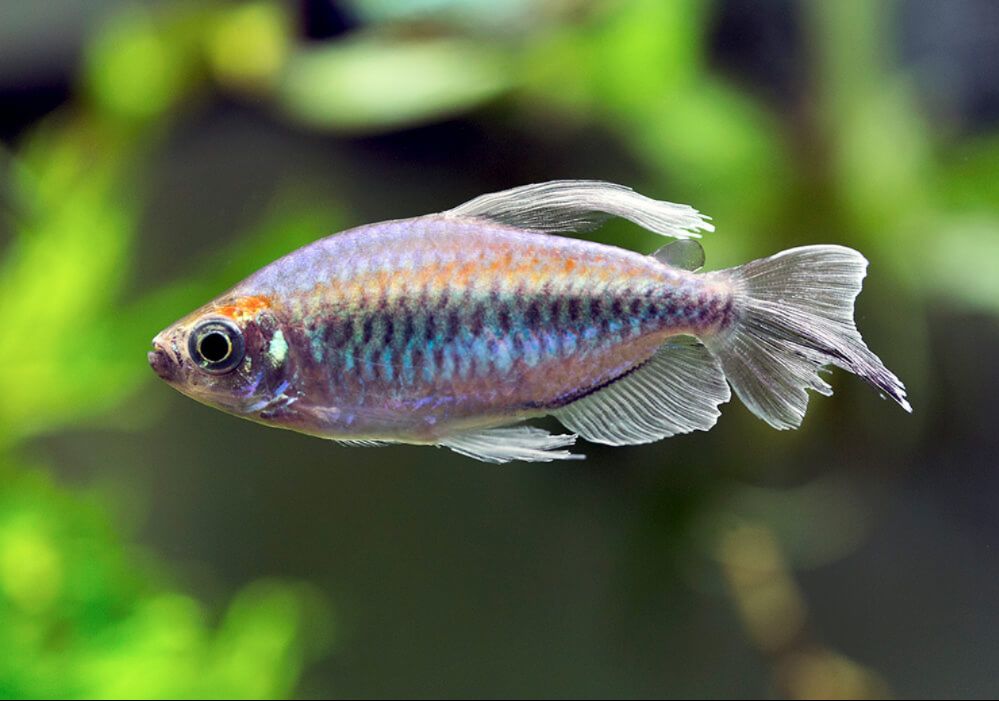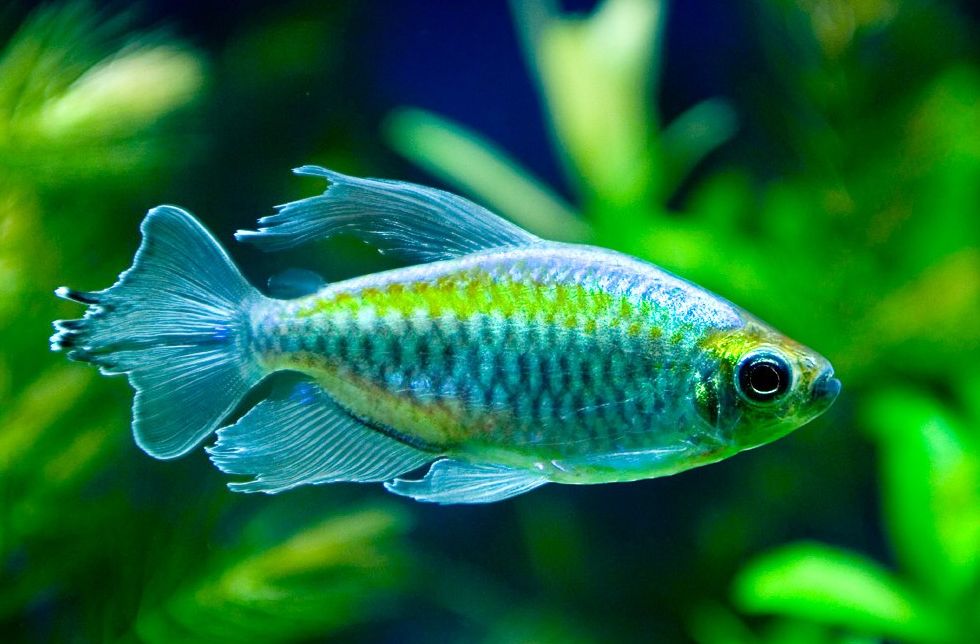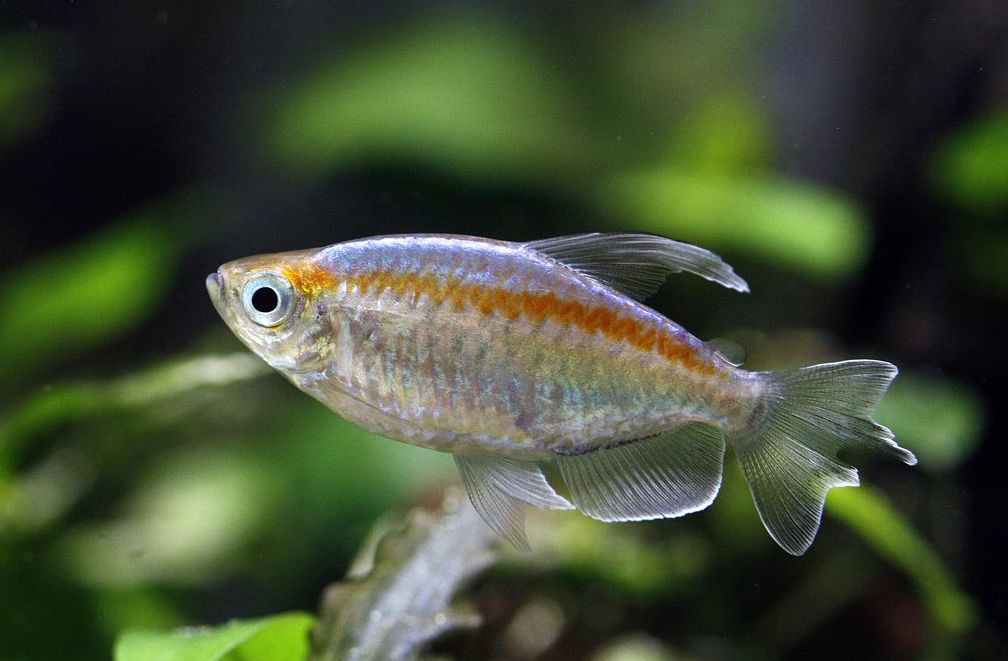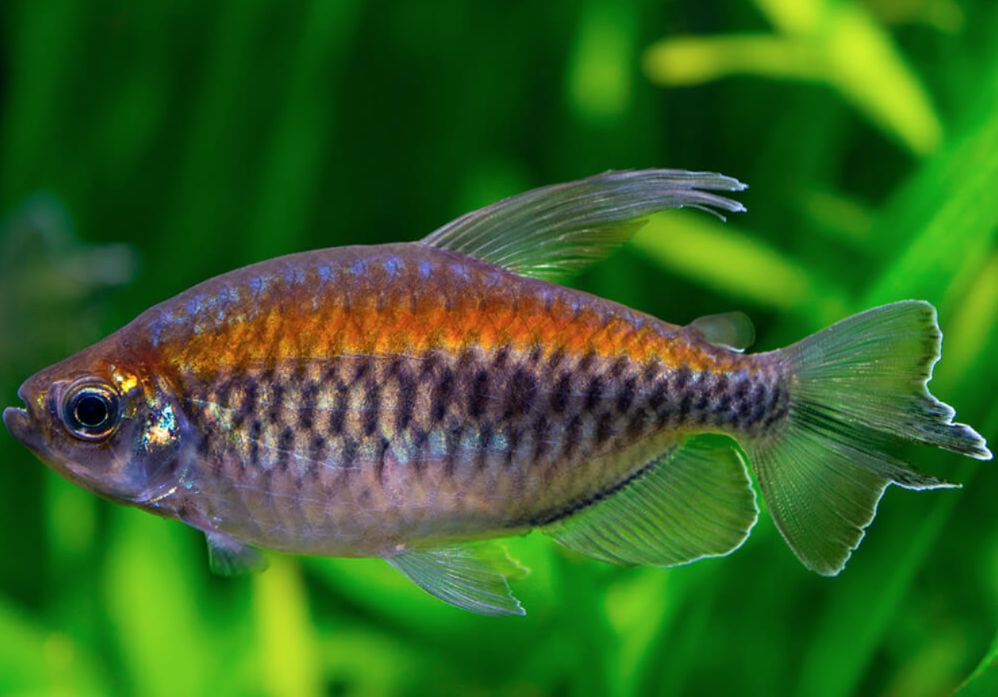The Congo tetra (Phenacogrammus interruptus) is a strikingly beautiful aquarium fish known for its vivid colors and graceful movements. Considered one of the most stunning members of the Alestidae family, this fish adds a splash of color to any tank.
When kept in well-lit environments, the Congo tetra’s hues can vary dramatically, showcasing shades of blue, gold, and iridescent green. For aquarium enthusiasts looking to appreciate the full beauty of this fish, providing a planted tank with varying light sources can enhance its vibrant appearance.

Contents
Habitat in the wild
The Congo tetra (Phenacogrammus interruptus), first described in 1899, is a vibrant fish native to the Democratic Republic of the Congo, specifically the Zaire River basin and the upstream Congo River.
In their natural habitat, Congo tetras thrive in slow-moving rivers, streams, and flooded forest areas, where the water is often rich in nutrients and characteristically adorned with dense vegetation, submerged branches, and leaf litter. These fish can be found in both clear and turbid waters, preferring regions with moderate water flow that offer ample hiding spots.
Congo tetras are highly adaptable, occupying various levels of the water column—from the midwater to the upper regions. They are well-suited to the dimly lit environments beneath the forest canopy, where sunlight filters through the lush vegetation, creating a tranquil habitat.
In the wild, Congo tetras coexist with a diverse array of species, including other tetras, characins, cichlids, and catfish. They are social fish that thrive in schools, forming tight-knit groups that enhance their safety and provide opportunities for social interaction. Understanding these natural behaviors and habitats is essential for replicating the ideal conditions for Congo tetras in your aquarium, ensuring they flourish both physically and socially.

Description
Size
The Congo tetra is a relatively large member of the tetra family. Males typically reach a maximum size of around 3.5 to 4 inches (9 to 10 cm), while females can grow up to 6 cm. It’s important to note that individual sizes may vary, with males often being slightly larger than females.
Understanding their size is crucial for aquarium enthusiasts, as it influences tank space and compatibility with other fish species.
Lifespan
Congo tetras can enjoy a lifespan of about 3 to 5 years when provided with proper care and optimal conditions. Understanding what influences their longevity is crucial for any fishkeeper. Factors such as tank maintenance, a balanced diet, and a stable social environment all play significant roles in ensuring these stunning fish live healthy and fulfilling lives. By prioritizing these aspects, you can help your Congo tetras thrive for years to come.
Body
Congo tetras boast a streamlined and elongated body shape, characteristic of many tetra species, but their elegance sets them apart. With lush fins that enhance their beauty, males exhibit long, veiled edges on their dorsal, anal, and caudal fins. The prominent dorsal fin stretches gracefully from the middle of their body to the tail, while the anal fin and caudal fin further contribute to their striking appearance. Notably, males feature a three-bladed tail with a pronounced middle blade, making them a captivating addition to any aquarium.
| Characteristic | Description |
|---|---|
| Scientific Name | Phenacogrammus interruptus |
| Common Name | Congo Tetra |
| Adult Size | Up to 3.5 to 4 inches (9-10 cm) |
| Lifespan | 3-5 years (can vary based on care and conditions) |
| Water Parameters | pH: 6.0-7.5 Temperature: 75-82°F (24-28°C) Hardness: Moderate |
| Tank Size | Minimum 20 gallons for a small group, larger for larger groups |
| Behavior | Peaceful, shoaling fish |
| Compatibility | Peaceful community fish, tetras, rasboras, dwarf cichlids |
| Diet | Omnivorous, accepts flakes, pellets, live/frozen foods |
| Natural Habitat | Slow-moving rivers, streams, and flooded forest areas |
| Preferred Water Flow | Moderate |
| Preferred Lighting | Dim lighting with some shaded areas |
| Coloration | Iridescent blue upper body, bright red/orange/yellow fins |
| Breeding Difficulty | Moderate |
| Breeding Trigger | Temperature drop, increased water flow, soft water conditions |
| Social Structure | Shoaling fish, thrives in groups of 6 or more |
| Suitable Tank Setup | Well-planted tank with open swimming space |

Care and keeping in a tank
Congo tetras are lively swimmers known for their playful behavior, which often leads them to jump out of the water. To ensure their safety, it’s crucial to keep the tank securely closed. These fish prefer to swim in the upper and middle layers of the water, so providing ample space in those areas will create a more comfortable environment. Designing a tank with a well-sealed lid and plenty of vertical swimming space will help these beautiful fish thrive while minimizing the risk of accidental escapes.
Tank size
Congo tetras are quite large for their species and thrive best in groups, making it essential to provide them with ample space. A minimum tank size of 20 gallons (75 liters) is often recommended for a small school of Congo tetras. However, larger tanks are preferable for these active fish, as they require both horizontal swimming space and vertical areas to explore. For example, a tank measuring at least 30 inches in length will allow them to swim freely and interact socially, enhancing their overall well-being. Providing a spacious environment not only benefits the fish but also creates a more dynamic and enjoyable aquarium for you to observe.
Water parameters
To ensure the health and vitality of Congo tetras, it’s essential to replicate their natural habitat, which features soft, acidic water. Aim for a general hardness (GH) level of 5-12 dGH and a carbonate hardness (KH) level of 2-8 dKH. Maintaining a slightly acidic to neutral pH range of 6.0-7.5 is ideal, although these fish can tolerate a broader range.
Keep the water temperature between 75-82°F (24-28°C) to reflect their tropical origins and promote their overall health and activity.
When introducing Congo tetras to a new tank, consider using substances for artificial water aging, such as peat or a peat filter insert. Alternatively, you can use water from an established tank to help create a suitable environment.
For care, perform monthly water changes of 1/5 to 1/6 of the tank’s capacity if there are no other fish present. If you have additional fish in the tank, gradually increase the water changes to 20% weekly. Adequate aeration and filtration are also crucial to maintaining water quality and ensuring the well-being of your Congo tetras.
Tank decor
To fully appreciate the beauty and behavior of Congo tetras, creating an ideal habitat is key. These fish thrive in schools, so it’s best to arrange tank plants densely, leaving open space near the front for the entire school to swim freely.
A native biotope setup is ideal—use dark substrates, abundant plants, and some driftwood or branches to simulate their natural environment. These elements provide hiding spots and create interesting swimming areas. Consider adding some dried leaves to the substrate to mimic the brownish water of the Congo River, where these fish are found. Opt for a fine-grained substrate, such as sand or small gravel, to resemble the sandy or muddy riverbeds, avoiding sharp materials that could harm their delicate fins.
To replicate the subdued lighting conditions under the forest canopy, use dim or subdued lighting. This creates a comfortable and calming environment for your Congo tetras, enhancing their natural behavior and overall well-being.

Diet
Congo tetras (Phenacogrammus interruptus) are omnivorous fish that thrive on a balanced diet, making proper nutrition essential for their health and vibrancy. A high-quality staple flake or pellet food formulated for tropical fish serves as the foundation of their diet. To mimic their natural eating habits, it’s beneficial to supplement their diet with occasional feedings of live or frozen foods, such as brine shrimp, daphnia, bloodworms, and mosquito larvae.
A well-rounded diet for Congo tetras should consist of approximately 60% animal feed (like bloodworms, tubifex, and brine shrimp) and 40% plant-based feed (such as filamentous algae and spirulina). If their diet lacks plant components, Congo tetras may begin to nibble on the soft parts of tank plants. You can further enrich their diet with blanched spinach, lettuce, or finely chopped vegetables like zucchini or cucumber.
One challenge to be aware of is that Congo tetras are timid and may struggle to compete with more active tank mates for food. They might even hesitate to eat until they feel secure, so it’s important to ensure they have ample opportunity to access their meals.
Tank mates
They are generally peaceful and can coexist with a variety of compatible tank mates. Tank mates can consist of the majority of small african and South American fishes, live-bearing fishes and barb (except, maybe the tiger barb), corydoras (like pygmy or panda), dwarf cichlids like ram cichlid. However, still it’s more proper to keep congo tetras in a school of 4-20 species separately from other fishes.
Here are some suitable tank mates:
- Harlequin Rasboras (Trigonostigma heteromorpha)
- Neon Tetras (Paracheirodon innesi)
- Ember Tetras (Hyphessobrycon amandae)
- Glowlight Tetras (Hemigrammus erythrozonus)
- Black Neon Tetras (Hyphessobrycon herbertaxelrodi)
- Cardinal Tetras (Paracheirodon axelrodi)
- Rummy Nose Tetras (Hemigrammus rhodostomus)
- Dwarf Gouramis (Trichogaster lalius or Trichogaster chuna)
- Sparkling Gouramis (Trichopsis pumila)
- Celestial Pearl Danios (Danio margaritatus)
- White Cloud Mountain Minnows (Tanichthys albonubes)
- Dwarf Rasboras (Boraras spp.)
- Endler’s Livebearers (Poecilia wingei)
- Guppies (Poecilia reticulata)
- Platies (Xiphophorus spp.)
- Corydoras Catfish (Corydoras spp. – pygmy cory, panda cory, adolfoi catfish)
- Otocinclus Catfish (Otocinclus spp.)
- Bristlenose Plecos (Ancistrus spp.)
Gender differences: male vs female
Distinguishing between male and female Congo tetras can be quite fascinating, as their differences are quite pronounced. Males typically have a more elongated body shape and can grow slightly larger than females. They also display longer, flowing fins, particularly a pronounced dorsal fin that extends farther along their bodies.
In terms of coloration, males exhibit more intense and deeper hues, especially during courtship or when asserting dominance. In contrast, females are generally smaller, less brightly colored, and possess a larger, rounder abdomen—especially noticeable when they are carrying eggs during breeding conditions.
Breeding
Approximately 2 weeks earlier before breeding starts the congo tetra male and female should be put apart into different tanks and fed well and high. The fish becomes reproductive at the age of 8-9 month.
The spawning may occur both within a couple and in a school, but the latter is more desirable (the males should prevail in this case). A spawning tank should be of 20 liters of 100-150 liters capacity correspondingly.
The spawning is seasonal and usually the morning one. It’s activated by adding of fresh, soft water; temperature and water flow increase; light day extension and high feed. The eggs are shed among the plants or on the tank bottom. Please, note, that in the old water, due to high content of nitrogen compounds in it, the juveniles stop growing and die as a rule.
Put a separating grid on the spawning tank bottom and it’s desirable to put a large bush of Thai fern on top of it. Water hardness is 1,5-5, pH 6,8-6,5, water temperature 25-28 °C.
After pouring water into the spawning tank, close it with clean glass and give the water about 2 weeks to settle. But don’t forget that the water settles using aeration. Put congo tetras into the spawning tank in the evening. Gradually raise the water temperature up to the optimal value. As a rule, the spawning stars in 2-6 days and it lasts for about 2.5 hours.
The light should be bright and close to the sunlight. The fish productivity is 300-500 transparent not sticky eggs. After the spawning remove the fishes, the substrate and the grid from the spawning tank and replace almost all tank water with the water with the same parameters and color it with methylene-blue a little.
The eggs should be shaded and the whitened ones should be removed. The healthy eggs are round and completely transparent.
The eggs incubation time is 5-7 days. One or two days earlier before larva appear decrease the tank water level up to 3-5 cm. The juveniles hatch in 6-7 days and they start swimming and feeding right away.
Start feed for congo tetra juveniles is infusorians, rotifers, boiled egg yolk, starting from the second week of juveniles life they can be fed with brine shrimp nauplii and cyclops, Vinegar eels.